Manifold Gauge Reading 0 on Suctionand 100 on High Side
Air-conditioning pressure approximate readings
Diagnose AC pressure gauge readings
How to diagnose automobile AC force per unit area judge readings
You can't accurately diagnose your auto'due south AC by using just the low-pressure level gauge on a recharge kit because you're only seeing pressure on the suction or low side of the unabridged system. That's not enough information to diagnose a problem. It's like trying to diagnose your overall health with only half of your blood pressure level reading.
Look, I know you want to figure out your Air-conditioning problem yourself without buying whatever tools, simply y'all tin really screw up your car'due south AC if you overcharge or undercharge the organisation. Overcharging really REDUCES cooling and undercharging can impairment the compressor (refrigerant carries the lubricating oil so depression refrigerant = oil starvation for the compressor).
So, if you really desire to diagnose and fix your AC system yourself,
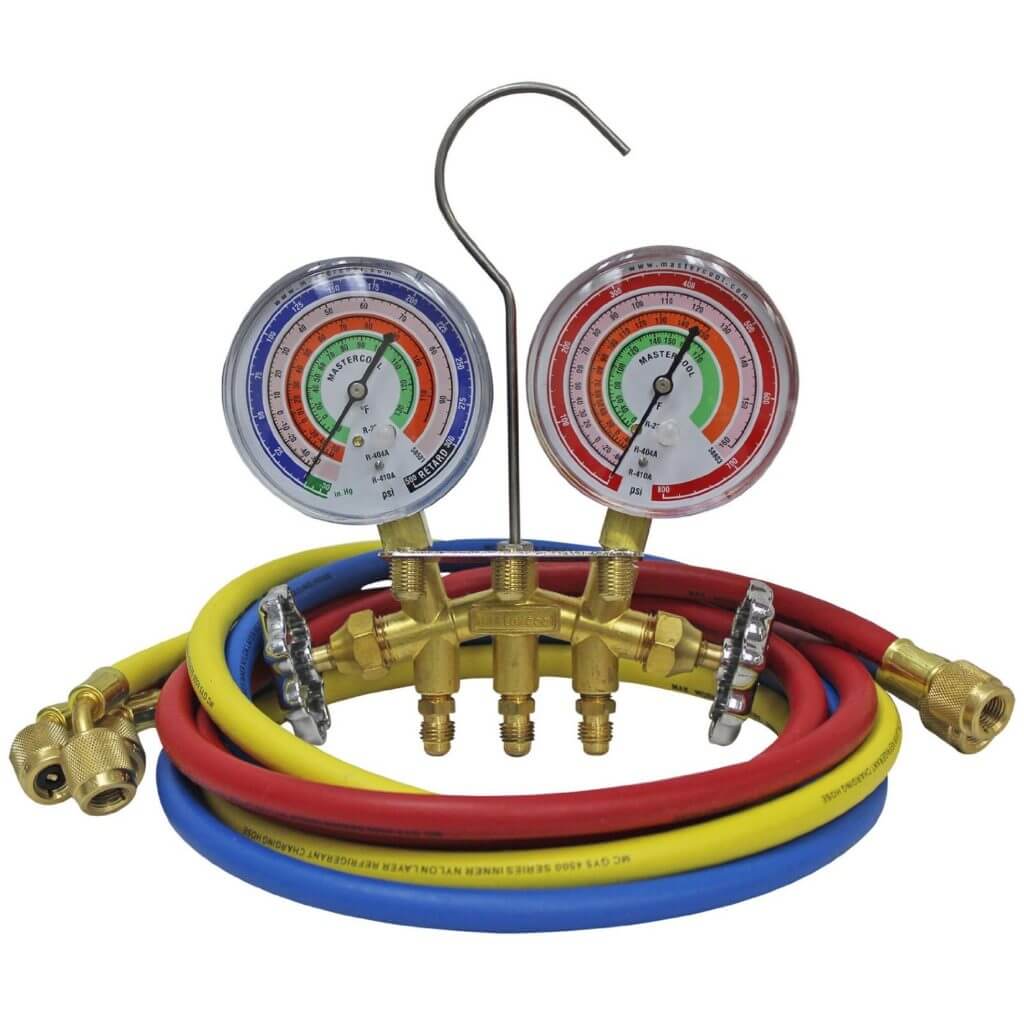
Manifold guess set with hoses
you'll need an Air conditioning manifold gauge set and hoses. Purchase a set or rent a fix, just don't kid yourself into thinking y'all can make whatsoever kind of diagnosis without it.
Start your Ac pressure readings diagnostic past measuring the organisation'southward STATIC pressure
Static pressure is the pressure with the system at residue (compressor off for at least thirty-mins). Attach to the hoses and judge fix to the loftier and low side ports of your AC system.
ane. With the engine OFF for at least 30 minutes, read the low and loftier-pressure gauges. They should exist the same because the loftier and low side pressure equalize in one case the compressor shuts off. It takes a while to equalize, that's why you lot must wait 30-mins to check static force per unit area
2. Measure ambient air temperature at the vehicle and under the hood WITH A THERMOMETER (practise non use weather service temperatures). The static pressure correlates to the temperature of the Ac components under the hood, not exterior in front of the vehicle.
3. Compare the pressure level readings to the pressure level-temperature nautical chart below
R-134a Static Temperature pressure chart
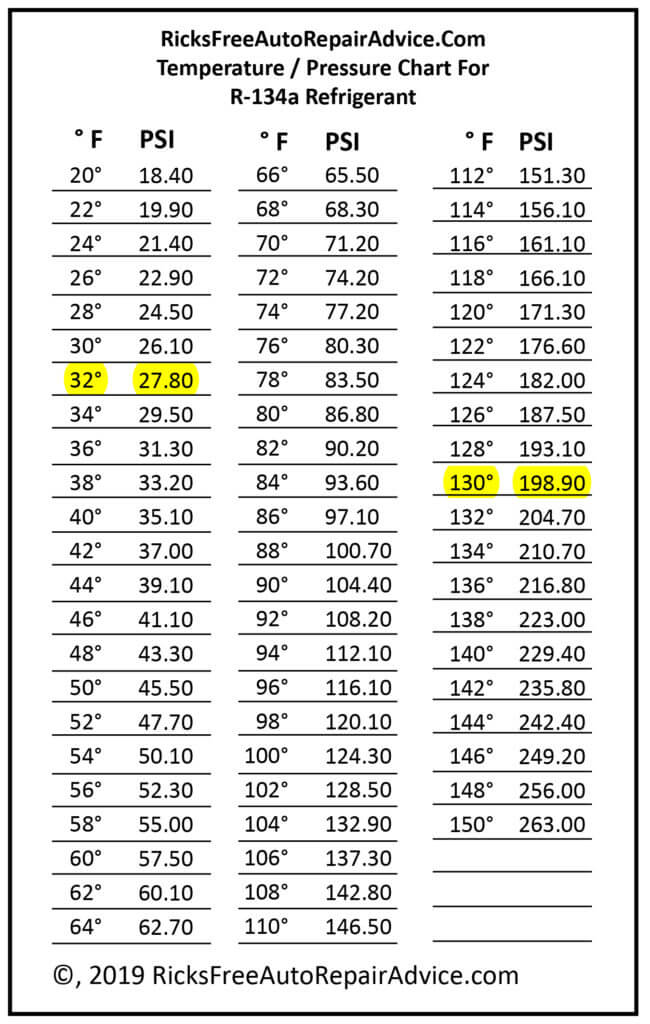
WARNING: Ambient temp is the temperature at the vehicle under the hood, Non THE Conditions SERVICE.
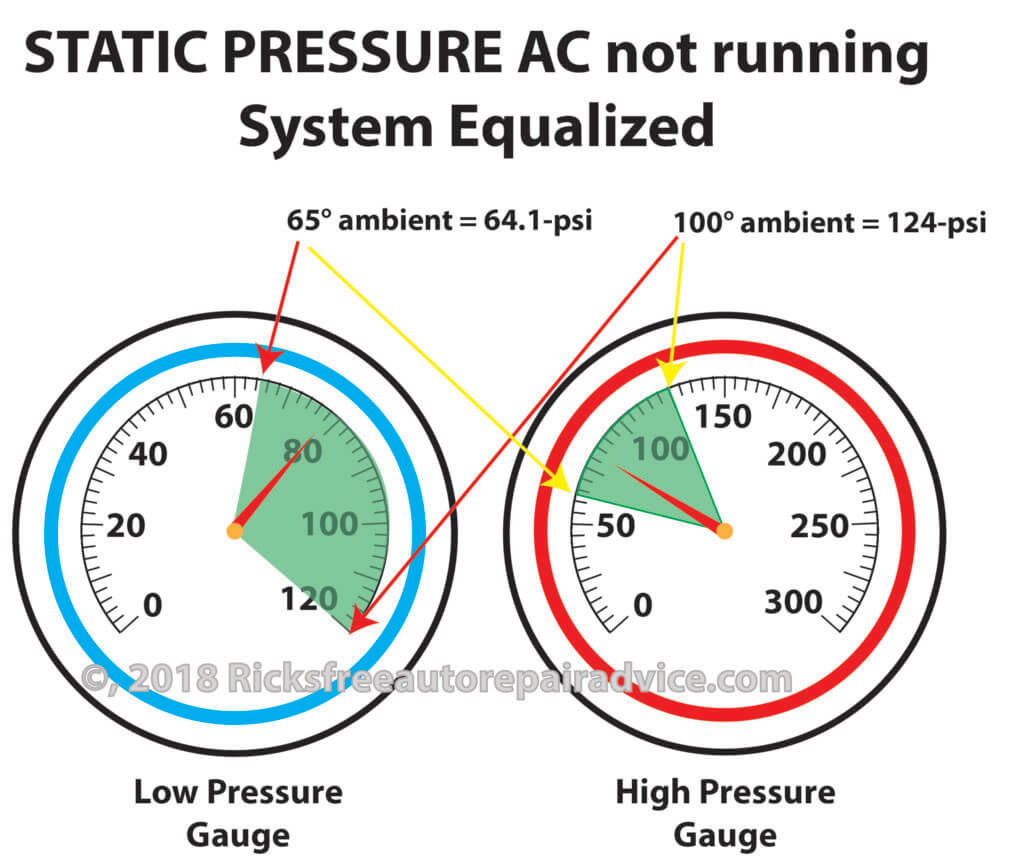
What static pressures actually ways
A depression static pressure level reading means the system is low on refrigerant
Static pressure level only tells y'all two things
If the low and high side gauges read the aforementioned pressures and the readings correlate to the pressures/temperatures shown on the chart above, they just tell you two things:
- The system isn't completely empty
- The system pressure is high enough to enable compressor clutch engagement.
If the static pressure level is lower than 27-psi. with an ambient temperature to a higher place 33°) the AC organisation volition not engage the compressor and you will not get any cooling.
If the gauges aren't the aforementioned during a static pressure test
If the gauges don't read the same during a static pressure level test, it means:
1) You haven't waited long enough for the pressures to equalize, or
2) The orifice tube, expansion valve, compressor reed valves or stuck or there'southward a severe restriction somewhere in the organization that'southward preventing the force per unit area from equalizing. In that case, you must fix that problem starting time.
Troubleshooting incorrect static pressures
If your static pressure readings don't match the temp/pressure chart and are also high (nearly common) these are the likely causes:
-
- Air in the organisation from leaks
- Overcharged
- Refrigerant is contaminated
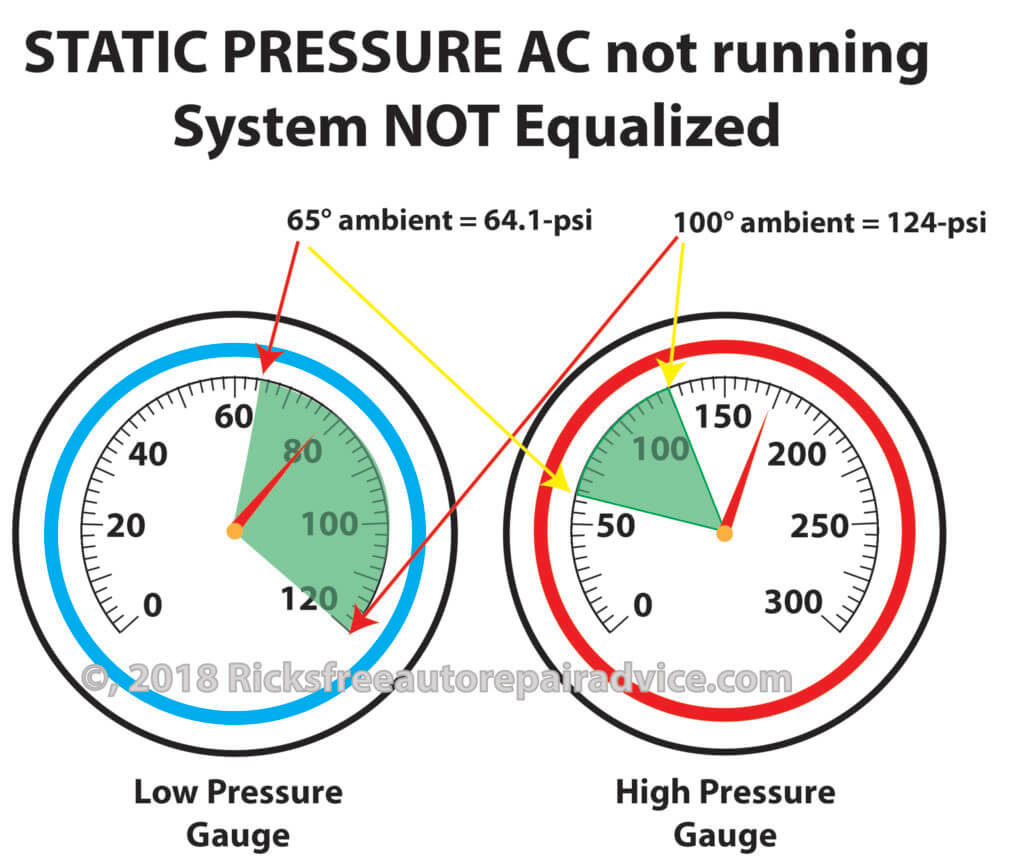
What 0 static pressure level means
The entire AC organization is empty due to a major leak. Find the leak and fix before refilling.
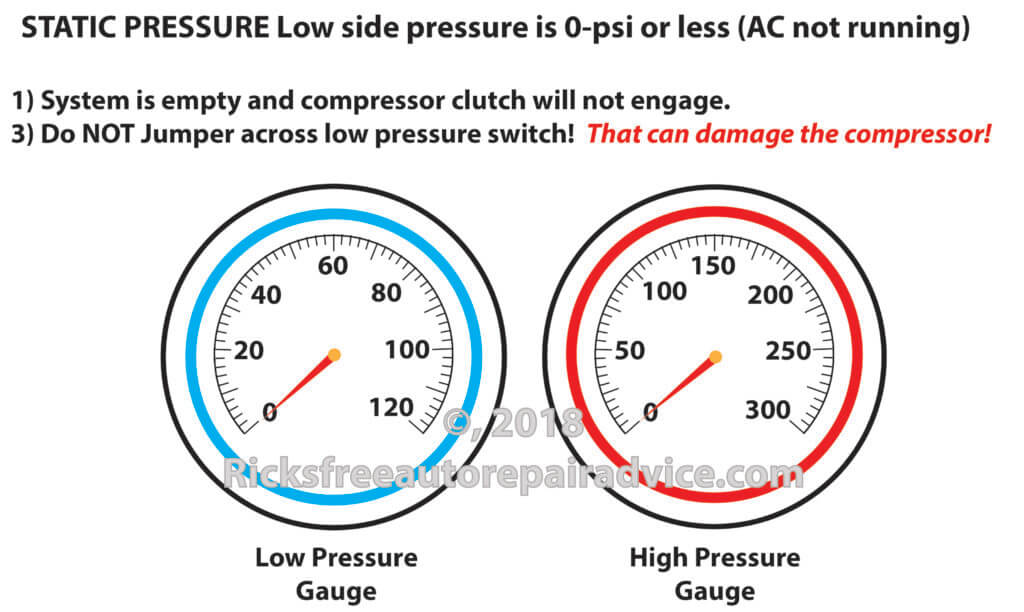
What are normal AC guess pressures when the system is running?
Generally speaking, you want effectually 27-psi on the low side and 200 on the high side. Why 27-psi? Because, on an R-134a AC system, 27-psi. on your guess means the refrigerant will produce near 32°F at the evaporator (as long as the orifice tube/expansion valve is operating properly and there'due south no air in the system that's artificially inflating the force per unit area to 27-psi). That's just around the freezing point of water.
On the high side, R-134a pressures unremarkably run 2.ii to 2.5 times the ambient temperature inbound the condenser. So, if the ambience temperature is eighty°F, you'll run across high side pressures running betwixt 176-psi and 200-psi. on an R-134a system. At 200-psi. the refrigerant entering the condenser volition be around 130°F.
For more than information on normal Air conditioning pressures, see the charts below.
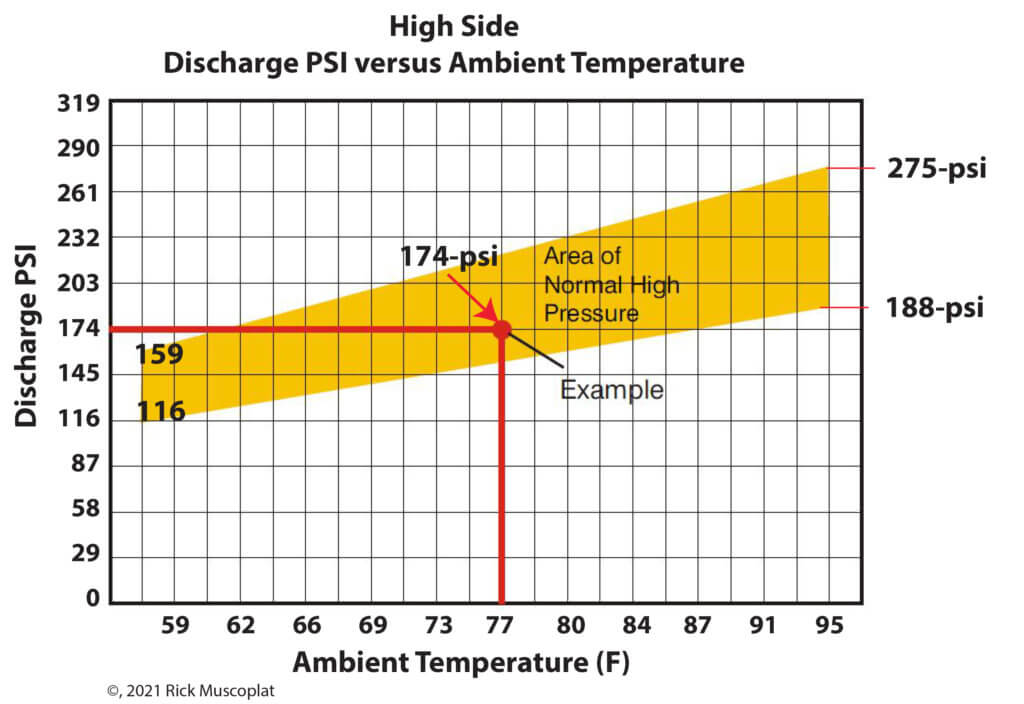
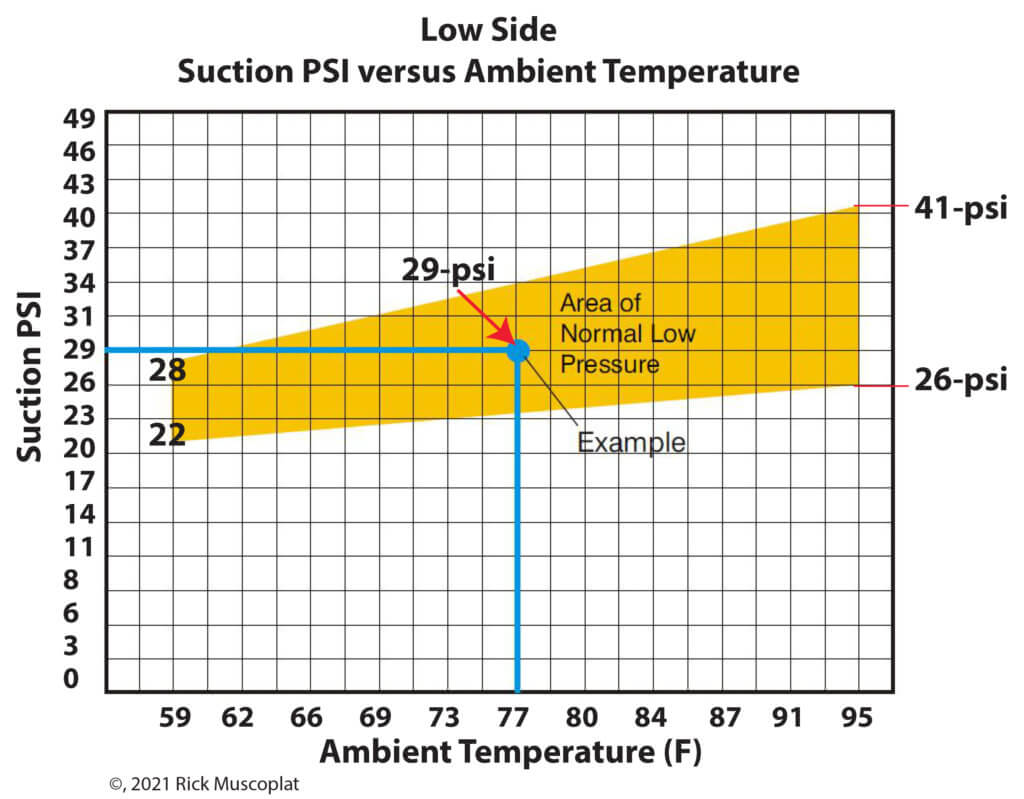
Normal loftier and low Ac ambient temperature pressure list
Ambient Temperature in °F Depression side Pressure Approximate reading and High side Pressure Gauge reading
65°F Ambience temperature: Low side pressure 25-35 psi High side force per unit area 135-155 psi
lxx°F Ambient temperature: Depression side force per unit area 35-40 psi High side pressure 145-160 psi
75°F Ambience temperature: Low side pressure 35-45 psi High side force per unit area 150-170 psi
eighty°F Ambient temperature: Depression side force per unit area 40-50 psi High side pressure level 175-210 psi
85°F Ambient temperature: Low side pressure 45-55 psi High side pressure 225-250 psi
90°F Ambient temperature: Low side pressure 45-55 psi High side pressure level 250-270 psi
95°F Ambient temperature: Low side pressure 50.55 psi High side force per unit area 275.300 psi
100°F Low side pressure l-55 psi Loftier side force per unit area 315-325 psi
105°F Ambient temperature: Low side pressure 50-55 psi High side pressure 330-335 psi
110°F Ambient temperature: Low side pressure fifty.55 psi High side pressure 340.345 psi

Annotation: Loftier humidity and airflow velocity across the evaporator and condenser take a direct upshot on pressure readings.
How to examination AC pressures with a manifold approximate
ane, Set the Air-conditioning controls to MAX and RECIRCULATE
2. Blower set to HIGH speed
iii. Close the doors. Windows tin can be open.
4. In one case you attach your gauges and start your engine, keep RPMs steady at effectually one,200 to 1,500 RPM.
Continue in listen that Air-conditioning pressures and centre duct temperatures are directly related to ambient temps and relative humidity.
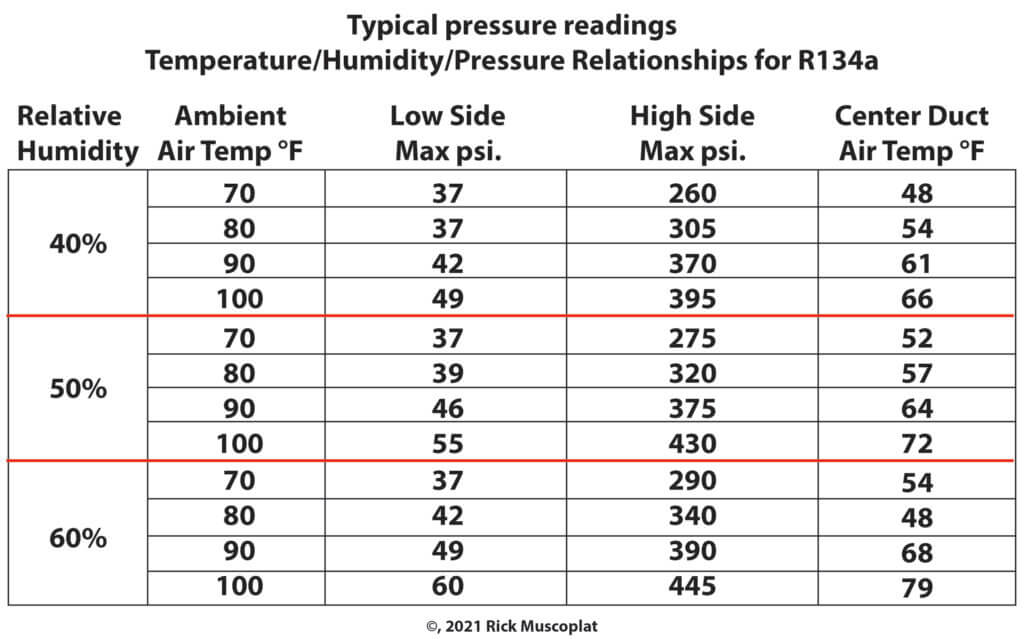
If your readings are outside the typical pressure/temperature range, run into below.
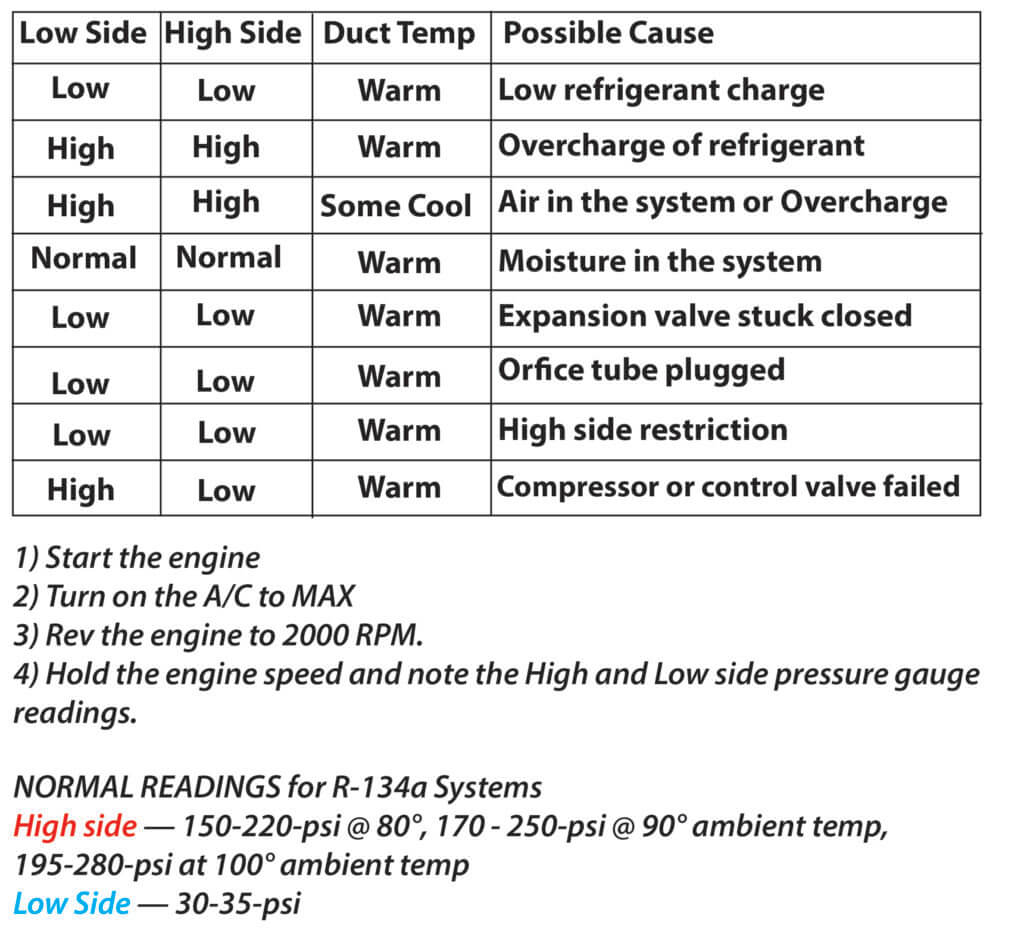
What the Ac guess pressures mean
Offset, to properly diagnose AC pressures when the Air-conditioning is running y'all MUST know what type of AC system you lot're working on . Is it a cycling clutch orifice tube system or an expansion valves system? If you lot don't know the divergence, you can't diagnose past pressures.
Come across this mail to learn what type of Ac system is in your vehicle.
Low and Loftier AC pressures are nearly the aforementioned
If the compressor is running (center portion of the pulley is turning), the compressor is spinning just not pumping. That'due south an indication of a bad compressor. If the centre pulley isn't turning, see this post for diagnostics.
Symptoms of a bad AC compressor
• Low and high side pressures are almost the same (similar eighty-psi depression side and 80-psi high side) AND you have to increment RPM quite a fleck to get pressures into the normal range AND you detect the air but gets cold when you're driving AND you've ruled out a low refrigerant charge or bad orifice tube/expansion valve.
Depression and High AC gauge pressures are high with no fluctuation
The system is overcharged, there's a lack of airflow across the condenser (clogged fins, radiator/condenser fans not working or not working at the proper speed), or you have air and moisture in the organisation.
What to do if Air conditioning pressures are high:
i. Check the front of the AC condenser (information technology'south in front of the radiator) to make sure the fins aren't clogged.
2. Cheque to make sure the radiator fans are working at the proper speeds.
3. Evacuate the system and recharge with the right refrigerant charge and examination again.
Low and Loftier Air-conditioning pressures are lower than recommended on an orifice tube system
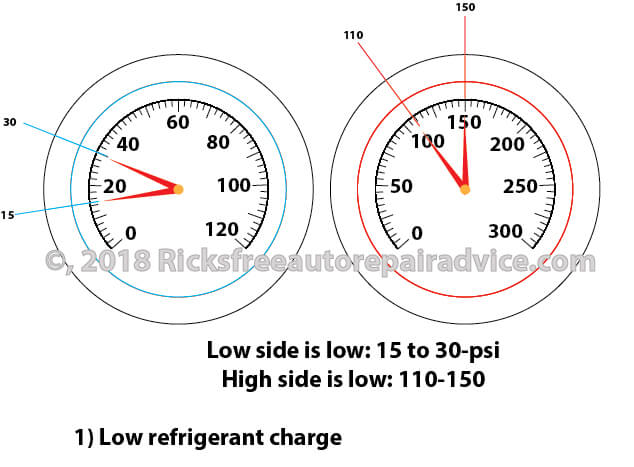
Symptom: Low cooling
Force per unit area readings: Low side is low. High side normal to slightly low
Causes: Low on refrigerant charge
In this example, the evaporator is starved for refrigerant. In a fixed orifice tube system, y'all want the evaporator almost completely full of refrigerant. When properly charged, a total evaporator volition spill some boiling refrigerant into the accumulator where it will continue to vaporize before entering the compressor.
All the same, if the system is low on charge, the evaporator is only partially filled with refrigerant, and then half of it will be cold and the other half hot. This frequently causes evaporator icing, where ice builds upwardly on the evaporator. The ice blocks airflow and the depression pressure triggers the low-pressure switch.
Depression refrigerant charge causes superheat
Continue in mind that AC works when the refrigerant removes just enough heat from the air to cause the refrigerant to change from a liquid to a vapor. However, in a partially filled evaporator, the vapor then absorbs heat. This is called superheat and in an orifice tube system, the superheated refrigerant is what causes evaporator icing
In other words, the low refrigerant charge causes the refrigerant is in the system to sit down too long in the evaporator. So the refrigerant picks up too much heat. First, it picks upwards enough estrus to cause the refrigerant to change state from liquid to gas. THEN, the gas absorbs even more heat from the evaporator airflow, causing evaporator temperature to autumn below the freezing signal of h2o. Any ambient moisture immediately freezes on the evaporator fins.
Examination for evaporator freeze-up
To test for evaporator freezing, turn off the engine and go out the vehicle for a while. When you return, examine the pool size under the vehicle. A large puddle is an indication of evaporator ice that has melted and drained onto the ground.
OR, continue driving the vehicle with the blower on High while monitoring airflow from the vents. Once the evaporator ices over, you lot should observe a dramatic reduction in airflow from the vents. The compressor volition shut off once the depression pressure triggers the low-pressure switch. The blower will melt the water ice. Low side pressure will increase to the point where the depression-pressure switch activates the compressor. So you'll get cold air once again—until the evaporator ices up again. The pattern will repeat over and over.
Notation: Low airflow across the evaporator, acquired by a plugged cabin air filter, can mimic the symptoms of a low refrigerant accuse. Too, a faulty evaporator temp sensor tin forbid the system from shutting downward one time the evaporator has iced over.
Restricted or plugged orifice tube can also cause low pressure on an orifice tube arrangement
Restriction in the low side of the arrangement. For example, a restricted orifice tube volition cause the compressor to suck, but the brake/clog in the orifice tube prevents the full flow of refrigerant, causing evaporator starvation. Low side pressure drops below low-pressure level switch threshold, which shuts off the compressor.
What causes orifice tube restriction?
Debris is bottleneck the orifice tube screen
• Metallic clothing particles from the compressor clog the orifice tube screen.
• Prophylactic hoses deteriorate over time and rubber particles clog the orifice tube screen.
• Moisture in the system reacts with the refrigerant and oil to form acids and sludge that clog orifice tube screen
• Moisture in the organisation that freezes at the orifice tube and restricts refrigerant flow through the orifice. An Ac system leak allows moisture into the system. The wet travels with the refrigerant. Since the temperature is near the freezing betoken of water right at the orifice tube, the wet freezes, cutting off the flow of refrigerant into the evaporator.
To test for wet: Turn Air-conditioning off for ten-15 mins, then dorsum on. If the estimate reading goes back to a very low suction-side reading, the orifice tube or expansion valve screen is likely frozen. If the gauge reading is normal when beginning turned on and stays normal for a few minutes, you get cold air and then low side goes low, that's a sign of moisture in the system. Or, if you can admission the orifice tube, apply rut to the orifice tube as you sentinel system pressures. if the system force per unit area returns to normal once yous've applied oestrus to the orifice tube, the crusade may be wet in the system.
The orifice tube is the incorrect size
• the orifice tube is also big
• the orifice tube has been replaced and the O-ring isn't seated properly. In other words, the system can't build pressure.
Depression side AC pressure is VERY low and high side pressure is low: restriction

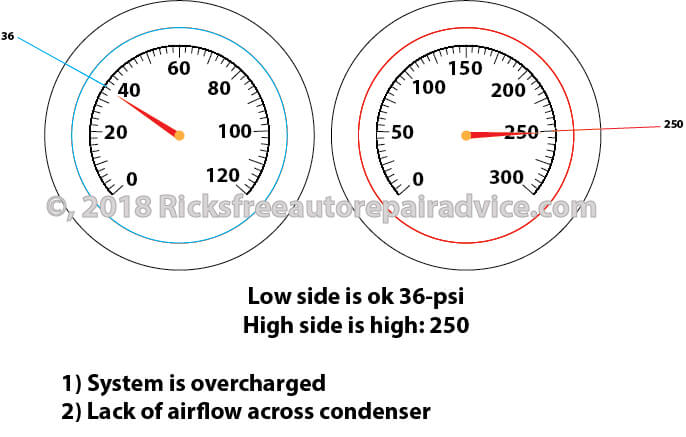
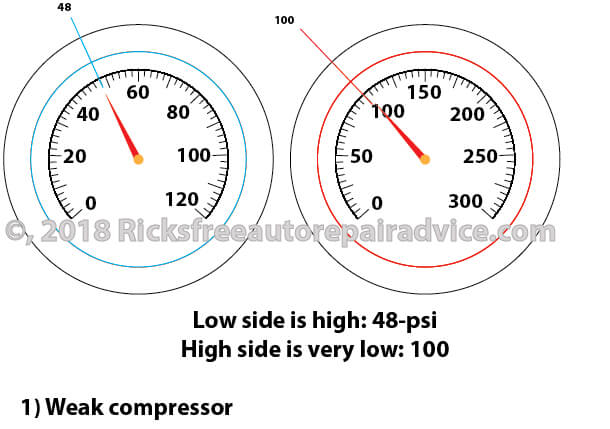
Low and High Ac pressures are lower than recommended in an expansion valve system where the valve is located on the evaporator outlet
The expansion valve is stuck open up so the system tin't build pressure level or the thermal seedling that measures evaporator temp isn't working properly and is causing the expansion valve to remain open up.
Low and high side AC pressures are normal but the air isn't cold
This may be a situation where the AC is working fine but the "heat is on," diminishing the effects of the Ac. This can be caused by a stuck air temperature door, faulty air temp/alloy door actuator or, in older systems, a stuck open up heater command valve that'due south running hot engine coolant into the heater cadre even though the heat is set to cold.
What to check:
Check heater control valve
Determine if the vehicle has a heater control valve. The valve is usually located under the hood and is opened and closed by a vacuum motor or cable. Look for heater hoses and either a cable or vacuum hoses running to a valve. Use a hand pump vacuum to operate the valve or motility the cablevision past hand to shut information technology off. Then checking cooling.
Check air temperature or blend door and actuator
If the cabin air temp is controlled by an air temp/alloy door, check actuator operation to see if it moves equally yous change the temperature setting. In some cases, the fix tin can exist equally simple equally replacing an actuator. If the actuator moves but the air door doesn't try moving the door by mitt. Many times the door tin get stuck or pause off from its hinges.
Bank check the motel air filter
Yeah, it's just like a furnace filter. If it'south chock-full, it can restrict airflow. That, in plow, causes the evaporator to freeze up which shuts off the AC. Don't skip this office. Many DIYers replace AC parts only to observe a clogged cabin air filter after spending hundreds on parts.
Cheque for a dirty evaporator whorl
Leaves and dust can clog the fins of an evaporator ringlet, reducing its ability to remove heat from your car. To access the evaporator coil, remove the blower motor resistor, and take a peek inside. To make clean the evaporator roll, utilize a foaming chemical cleaner.
For more than troubleshooting tips using gauges, see this post
©, 2020 Rick Muscoplat
Posted on by Rick MuscoplatSource: https://ricksfreeautorepairadvice.com/ac-pressure-gauge-readings/
0 Response to "Manifold Gauge Reading 0 on Suctionand 100 on High Side"
ارسال یک نظر